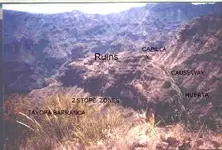HOLA amigos,
Looking into this document, the inventory of Tayopa, which is a primary source that ties the Jesuits to the mines and treasures of Tayopa, and those dates found on it - 1603 and 1646, we find it "fits" with a period of history in Mexico which was highly turbulent.
The name of the person who made the copy in 1646 was Right Reverend Father Guardian Fray, Francisco Villegas Garsina y Orosco, and the 1603 original mentions a Right Reverend Father Ignacio Maria de Retana, whom may or may not have been a Jesuit. Some sources on Tayopa state it was Franciscans who had it first. At any rate the Jesuit in charge of New Spain was Father Calderon, whom was replaced in March of 1645 by Father Juan de Bueras.
This just happens to be a period when the Jesuits were establishing new missions in Sonora, including the founding of Arizpe by Jesuit Father Geronimo de la Canal, also spelled with a "J". There was an epidemic which swept the country in that year too, and trouble with the Indians, which is very in keeping with the story of Tayopa. The Bishop Palafox we mentioned earlier made several long tours of the missions in 1643,44 and 46, which may be what resulted in his attacks on the various Orders with control of New Spain. It is also during this very period when the (contested) letter of Palafox mentions the Jesuits having "very rich silver mines". Or is it pure coincidence that letter accusing the Jesuits of having silver mines attributed to Palafox whom toured in 1646, the date of our inventory, dates to right after this. Could it be that he was simply referring to Tayopa, if not others? I think so.
What DID Bishop Palafox find in his tours? In one case, he found that in the estate of a deceased prelate, which was stated by magistrate Torreblanca as a value of 14,483 pesos, had failed to mention a number of other items brought by the archbishop from Peru - including a jewel-encrusted breastplate valued at 50,000 pesos, 43,900 pesos in silver, and two thick gold chains which Torreblanca had stolen with the assistance of his nephew - the "kicker" is that these riches had been stored by the bedside of the deceased archbishop, in two heavy boxes labeled, now brace yourself for you have heard this before, "somewhere" -CHOCOLATE. This was a considerable fortune for that time I would point out as well.
I don't have a list handy of all the names of Jesuits or other Orders priests or laymen who served in the frontier regions and doubt it can be found easily. I am not even sure that the Father de Retana named on the inventory was a Jesuit, he may well have been a secular priest. Another version has the padre whom casted the bells named Lorenzo.
Here is an extract listing the towns and dates they were founded in Sonora, during the time period when the inventory was taken at Guadeloupe de Tayopa
NOTICIA de la fundación de alguno lugares del tomada del sabio geógrafo Don Manuel Orozco y en su obra Geografía de las lenguas 6 carta de México NOMBRES Años Nuestra Señora de la Asunción Arizpe 1648 San Lorenzo Guepac 1639 Bacoaiz Bacoatzi Bacochi 1660 San José Chinipa 1648 Nuestra Señora de los Remedios de Beramitzi Ba namitzi 1639 San Ignacio Soniquipa 1646 Purísima de Babicora Babiacora Babicori 1639 Guásabas 1645 Oputo 1645 Bacadeguatzi 1645 Nacori 1645 Bacerac 1645 Babispe 1645 Oposura 1644 Cumpas 1644 Cuquiaratzi 1653 Cuchuta 1653 Teuricatzi 1G53 Tepache 1678 Yecori 1673 Guatzinera 1645
<Compendio de la geografia del estado de Sonora By José María Pérez Hernández MÉXICO TIP DEL COMERCIO A CAROO DE MABIANO LABA HIJO CORDOBANES NUMEBO 8 1872 pp139>
That the Jesuit missionaries were entering Sonora (and Sinaloa) by 1591, with the backing of the Spanish crown and military escorts
pesos alguno VIII En 1590 por cédula de Felipe II á solicitud de San Francisco de Borja general de la orden de la compañía de Jesús se concedió á sus regulares la conquista espiritual de las provincias de Sonora y Sinaloa y aunque se aseguró que no seria gravosa al tesoro real el resultado fue que entre los misioneros los colonos y la tropa consumieron mas de ocho millones de pesos desde 1591 á 1596 que si algo se logró alcanzar en ia conquista fue debido al eñcaz auxilio de Sebastian Vizcaino quien se retiró después con gran parte de su fuerza
<ibid>
You see amigos there have been some chapters of history erased. Whom is credited with the founding of Guevavi? When was it founded? 1691 by Father Kino right? Hmm, then why do we find this:
En 1638 los regulares de la compañía de Jesús se encargaron nuevamente de la educación civil y religiosa de los naturales siendo nombrado superior el RP Fr Bartolomé Castaño el que ayudado por vanos de sus compañeros fundó al gt nos pueblos y misiones entre ellos Nacozari B ivispe Pópulo Caborca Arivechi Güevavi Ona vas Comuripa Alamos Batuc Cucurpe Zoari pa Mobas Ures Babiácora Cocospera Oposura y otros
<ibid>
Two Guevavis? Notice also the town of Nacori - this one is important in the history of Tayopa. Spelling seems to be a major problem when researching this history, and with Tayopa there are numerous spellings. (I have seen several explanations for this, all will do) So we may well miss the fact, that here in 1730, a census found that a population of 386 Jobal Indios were living in the town of TEOPARI. If you say it out loud, you see the similarity to Tayopa, or Teopa, Tiopa, Taiope, etc. The editors failed to erase ALL traces.
In that 1730 census, we have another clue too - Jobal Indios. What tribe is that, you might ask? It is one division of the Opatas! Remember that in Espanol, B sounds very much like V.
Jova
A former Opata division inhabiting principally the valley of the stream on which Sahuaripa lat 29 Ion 109 is situated in Sonora Mexico and extending E into Chihuahua to and including the village of Dolores on a s tributary of Rio Aros Its members are now completely Mexicanized The language spoken differed dialectically from the Opata proper and the Kudeve The Jova settlements were Arivechi Chamada Natora Ponida Sahuaripa in part San Mateo Malzura Santa Marfa de las Dolores Santo Tomas Satechi Servas Setasura and Teopari F w H J ba Davila Sonora Hist 316 1894 Joba Iblil 317 Jobal CTOZPO y Berra Geoff 315 1864 Jobale Ibid Jova Ibid Ovai Ibid Bahua ripu Ibid
<from Handbook of American Indians north of Mexico, Volume 1 By Frederick Webb Hodge, Washington Government Printing Office, 1907>
Why is this part of history so "edited"? A good part of the answer is that in 1646 was a major Indian uprising, which resulted in the loss of Tayopa - which at the moment, if it was indeed a Cura, would have been the center where most records were stored. Only scattered documents have turned up which can be traced to Tayopa, always in the villages or rancherias around it. The archives of Tayopa itself might have simply been burned on the sack of the Real, or they may have been taken by the Indians as curious trophies (at least one document has this explanation of how it came to be in private Indians hands) or they may even be still stored in a vault room built for the purpose, waiting for someone to discover them and bring them back to light. Outside references to Tayopa are more mysterious - but remember Rule # 21, nothing which might redound to the discredit of our missionaries will be communicated to laymen.'
Tayopa had been in 'bonanza' (producing heavily) since 1632, but by 1646 they had not shipped out any silver for several years - they were stockpiling it. In fact all of New Spain was withholding silver shipments to Spain, partly to pay for defenses, partly for other reasons. One very good reason for the Real de Tayopa to "sit" on their silver was the robbery or rather "donacions" which occurred in 1631, 1637 and 1640, when all silver shipments which arrived in Spain were seized by the Crown and the owners forced to accept copper currency in place of it. Would you ship out tons of silver only to have them seized and exchanged for copper? There is quite a difference in value. So it is safe to say that Tayopa almost certainly had been holding back their shipments since 1641, by which time they got wind of the repeated forced 'donacions'.
This time period was turbulent around the world - the Dutch were assailing Brazil and warring with the English as they were a world power; the French too were making incursions. By the 1680's the British colonies 'almost' revolted and separated from the kingdom, a century before our final and successful revolution.
Cactusjumper states he has seen nothing to tie the Jesuits to Tayopa; this is to dismiss the inventory documents found by Henry Flipper, which dovetail surprisingly well with other historical sources. This is not the only document ever found to support the existence of Tayopa, Teopa, Teopari or Tiyopah as it has been variously spelled over the centuries. Opata Indians were still living in the area in the 1730's and it is from Opatas that at least one document (in private ownership) was found. The area lay today within Chihuahua state, but in the 1600's it was considered a part of Sonora.
Oh and Joe - did you notice, while taking note that miners, Indians etc were supporting the actions of de Retana, that this same de Retana left his personal estate to...(drum roll for drama) ...the Jesuits. He also stated that he was a bachelor and childless. Hmm.
Good luck and good hunting amigos I hope you find the treasures that you seek.

Oroblanco



 for that historical, factual truth. In the final analysis, I can live with Lamar's personality and, in fact, welcome it. After this many years, a little inspiration can't hurt.
for that historical, factual truth. In the final analysis, I can live with Lamar's personality and, in fact, welcome it. After this many years, a little inspiration can't hurt. 


![.jpgHeadquarters Cuartel.jpg[1]©@.webp](/data/attachments/357/357153-7bffdb6028bee86f776c1fd6db76e2e5.jpg?hash=mzzuMD3pYG)



